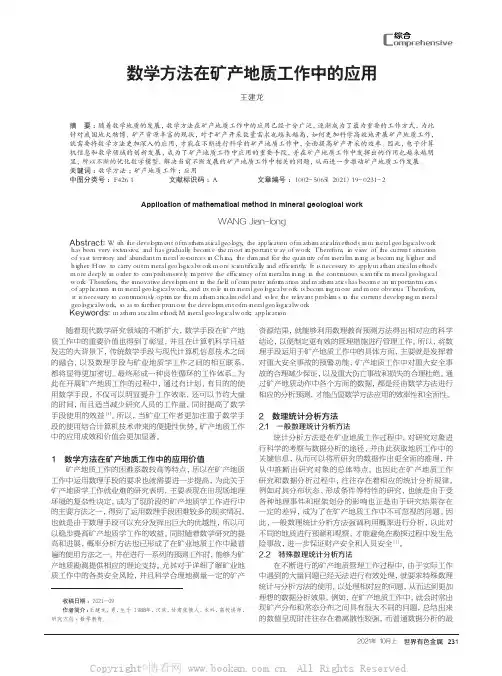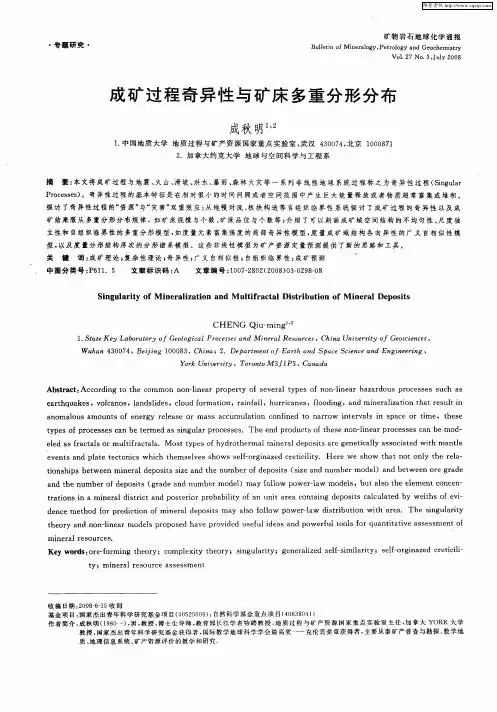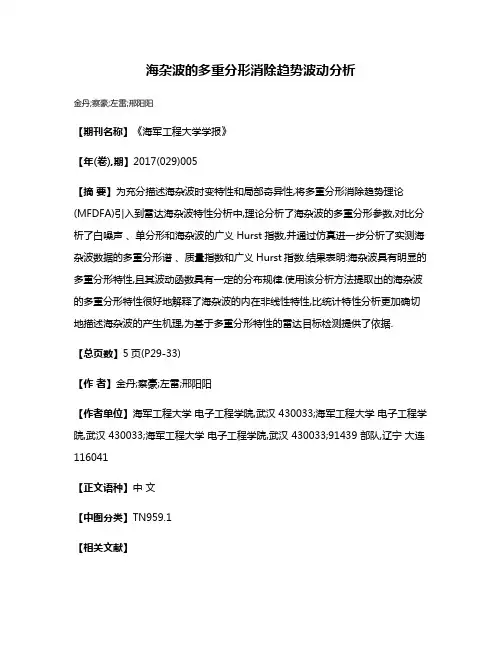多重分形局部奇异性分析方法及其在矿产资源信息提取中的应用.
- 格式:doc
- 大小:37.00 KB
- 文档页数:6

数学方法在矿产地质工作中的应用王建龙(兰州石化职业技术大学,甘肃 兰州 730207)摘 要:随着数学地质的发展,数学方法在矿产地质工作中的应用已经十分广泛,逐渐成为了最为重要的工作方式,为此针对我国地大物博,矿产资源丰富的现状,对于矿产开采数量需求也越来越高,如何更加科学高效地开展矿产地质工作,就需要将数学方法更加深入的应用,才能在不断进行科学的矿产地质工作中,全面提高矿产开采的效率。
因此,电子计算机信息和数学领域的创新发展,成为了矿产地质工作中应用的重要手段,并在矿产地质工作中发挥出的作用也越来越明显,所以不断的优化数学模型,解决当前不断发展的矿产地质工作中相关的问题,从而进一步推动矿产地质工作发展。
关键词:数学方法;矿产地质工作;应用中图分类号:F426.1 文献标识码:A 文章编号:1002-5065(2021)19-0231-2Application of mathematical method in mineral geological workWANG Jian-long(Lanzhou Petrochemical Vocational and Technical University,Lanzhou 730207,China)Abstract: With the development of mathematical geology, the application of mathematical methods in mineral geological work has been very extensive, and has gradually become the most important way of work. Therefore, in view of the current situation of vast territory and abundant mineral resources in China, the demand for the quantity of mineral mining is becoming higher and higher. How to carry out mineral geological work more scientifically and efficiently, It is necessary to apply mathematical methods more deeply in order to comprehensively improve the efficiency of mineral mining in the continuous scientific mineral geological work. Therefore, the innovative development in the field of computer information and mathematics has become an important means of application in mineral geological work, and its role in mineral geological work is becoming more and more obvious. Therefore, it is necessary to continuously optimize the mathematical model and solve the relevant problems in the current developing mineral geological work, so as to further promote the development of mineral geological work. Keywords: mathematical method; Mineral geological work; application随着现代数学研究领域的不断扩大,数学手段在矿产地质工作中的重要价值也得到了彰显,并且在计算机科学日益发达的大背景下,传统数学手段与现代计算机信息技术之间的融合,以及数理手段与矿业地质学工作之间的相互联系,都将显得更加密切。




基于栅格数据的局部奇异性分析迭代方法及其软件实现陈志军;成秋明;陈建国【摘要】近些年,弱缓化探异常识别已成为成矿预测和勘查评价中十分关键的问题.多重分形理论的局部奇异性分析因其崭新的思路、简便的方法、优良的效果而在弱缓异常识别中受到广泛关注.在深入剖析局部奇异性分析基本思想及计算方法的基础上,引入正规化尺度参数L,提出了迭代方法来改进局部奇异性指数的估值.给出了奇异性迭代算法并用C++编程实现,软件功能强劲,操作灵活,不仅适用于各向同性情形,还适用于各向异性尺度的奇异性计算和方向性奇异性计算.软件的动态链接库版本已在GeoDAS矿产资源定量预测专业软件中应用.【期刊名称】《地质学刊》【年(卷),期】2014(038)004【总页数】10页(P613-622)【关键词】局部奇异性分析;栅格数据;多重分形;迭代方法;正规化尺度参数【作者】陈志军;成秋明;陈建国【作者单位】中国地质大学地质过程与矿产资源国家重点实验室,湖北武汉430074;中国地质大学(武汉)资源学院,湖北武汉430074;中国地质大学地质过程与矿产资源国家重点实验室,湖北武汉430074;中国地质大学(武汉)资源学院,湖北武汉430074;York大学地球空间科学系和地理系,加拿大多伦多M3J1P3;中国地质大学地质过程与矿产资源国家重点实验室,湖北武汉430074;中国地质大学(武汉)资源学院,湖北武汉430074【正文语种】中文【中图分类】P628分形与多重分形在勘查地球化学数据、勘查地球物理数据、矿石品位数据等地质勘查数据中的普遍存在性为成矿过程奇异性与矿产预测定量化的新理论与新方法研究提供了崭新的思路和新型的数学工具(成秋明, 2007; Agterberg, 2003)。
不均匀性、自相似性(自放射性、广义自相似性)、奇异性等通常被用来描述地球化学场特征、矿床空间分布、热液成矿系统矿床品位-吨位分形模型的非线性性质。
一种五参数的多重级联模型最近被提出,该模型对de Wijs’s锌数据等多重分形经典数据的非对称奇异谱进行了成功建模,为现实世界中地球化学场多重分形性的存在性提供了理论依据。


海杂波的多重分形消除趋势波动分析
金丹;察豪;左雷;邢阳阳
【期刊名称】《海军工程大学学报》
【年(卷),期】2017(029)005
【摘要】为充分描述海杂波时变特性和局部奇异性,将多重分形消除趋势理论(MFDFA)引入到雷达海杂波特性分析中,理论分析了海杂波的多重分形参数,对比分析了白噪声、单分形和海杂波的广义Hurst指数,并通过仿真进一步分析了实测海杂波数据的多重分形谱、质量指数和广义Hurst指数.结果表明:海杂波具有明显的多重分形特性,且其波动函数具有一定的分布规律.使用该分析方法提取出的海杂波的多重分形特性很好地解释了海杂波的内在非线性特性,比统计特性分析更加确切地描述海杂波的产生机理,为基于多重分形特性的雷达目标检测提供了依据.
【总页数】5页(P29-33)
【作者】金丹;察豪;左雷;邢阳阳
【作者单位】海军工程大学电子工程学院,武汉 430033;海军工程大学电子工程学院,武汉 430033;海军工程大学电子工程学院,武汉 430033;91439 部队,辽宁大连116041
【正文语种】中文
【中图分类】TN959.1
【相关文献】
1.探测交通时间序列长相关性的多重分形消除趋势波动分析方法 [J], 商朋见;于建玲;
2.非平稳海杂波的消除趋势波动分析 [J], 丁昊;关键;黄勇;于仕财;何友
3.基于去趋势波动分析的多普勒域海杂波分形分析 [J], 张令波
4.安庆气温的多重分形消除趋势波动分析与预测 [J], 程花花;郑婷婷;万涛;张琛;章意成
5.基于2分随机乘法模型的多重分形海杂波建模研究 [J], 左雷;金丹
因版权原因,仅展示原文概要,查看原文内容请购买。


数值岩石试样破裂过程多重分形特征杨宇江;李元辉【摘要】采用数值分析的方法和 FLAC3D软件,建立服从应变软化关系的非均质岩石试样模型。
引入多重分形理论,通过盒计数法计算了单轴加载过程中峰前某一阶段单元体积应变的多重分形谱f(α)。
分析了f(α)-α曲线特征参数 Df和Dα随加载过程的阶段特征,不同均匀程度的岩石试样在临近峰值强度前Dα和f(α)max 的变化规律。
研究结果表明,采用多重分形理论对单元体积应变的空间分布特征进行描述,可以在较大的尺度内满足标度不变性。
通过不同的参量进行概率计算得出的f(α)略有不同,但动态变化规律相近,f(α)曲线呈左钩形状,随着载荷的增加 Df变大,而Dα变小。
当不是所有的盒子内都存在可测度的参量时,f(α)max 随载荷的增加而增长。
对于均匀程度不同的试样,峰前f(α)max 与Dα随均匀性的增加而减小,但在均匀性较高以后,逼近于某一常数。
%A heterogeneous strain softening rock specimen was established with the numerical code FLAC3D .The multi-fractal spectrum f(α)of the elements volumetric strain at the pre-peak of rock specimen under uniaxial loading was obtained by using the box-counting method.The change rules of multi-fractal spectrum characteristic parameters,Dαand Df,with the different stages of loading process were analyzed.The characteristics of the f(α)curve vertex f(α)max and Dαwith different heterogeneity of rock specimen near the peak strength was studied.The results show that the double logarithmic diagram would keep scale invariance in a wide range when the multi-fractal was used to describe the spatial structure of elements volumetric strain.The f(α)curves shape and variation are similar to different parameter probabilisticcalculation method.The shape of the multi-fractal spectrum show left hook.The Df increase with the loading process.At the same time,theDαtrend to decrease.If the possibility of null events exist in some of the boxes,the f(α)max increase with the loading.There is an obviously decrease tendency of the f(α)max and Dαwith the decrease of the heterogeneity within limit at the pre-peak of rock specimen.However,they would be constants while the homogeneity increased to a certain extent.【期刊名称】《计算力学学报》【年(卷),期】2016(033)005【总页数】6页(P796-801)【关键词】非均匀性;数值模拟;多重分形谱;标度不变性【作者】杨宇江;李元辉【作者单位】辽宁科技大学矿业工程学院,鞍山 114051;东北大学资源与土木工程学院,沈阳 110004【正文语种】中文【中图分类】TP273;O242.1分形几何是由Mandelbrot发展起来的一门新的数学分支,通过自相似性和分形维数来描述自然界不规则以及杂乱无章的现象和行为[1]。

基于多重分形理论的地表高程插值方法研究摘要:从地表高程插值的研究现状出发,将多重分形理论引入Kriging和IDW两种常见插值方法,并对四种插值方法进行了比较分析。
结果表明,在相同的样本数据条件下,多重分形插值的精度要高于IDW插值方法和Kriging插值方法。
通过对局部奇异性指数的计算,多重分形插值方法合理地强化了局部区域的估值结果,可以更好地表达整个地区高程的局部奇异性。
关键词:多重分形理论Kriging IDW 高程插值随着人们对空间高程数据的质量要求越来越高,高程插值被越来越广泛得应用在高程测量中,特别是由点源数据形成连续变化的曲面来表达高程值变化往往需要进行高程数据的插值或估计。
目前地形高程插值的方法主要有反距离权重方法(IDW)、克里格插值方法(Kriging)等[1,2],这些方法为了体现某种趋势而采用加权平均估计,将实际高程值较大的地方消减,实际高程值较小的地方增大,对数值造成一定的光滑,此时高程的局部结构特征的表示与实际有较大差距。
普通插值方法无法表达地表高程局部的复杂变异,无法对地表高程有较精确的预测。
Mandelbrot上世纪60年代提出的分形理论以分维数、自相似性和幂函数等为工具,研究起伏的地形、复杂的水系等具有特征标度、极不规则但具有自相似性的复杂现象[3]。
多重分形理论作为分形理论的进一步发展,不仅能够用来描述分形的复杂特征,还能特征描述分形本身的几何支撑度量。
对于高程、水流等诸多非均匀的分形现象,可以使用多重分形测度或维数的连续谱来表示[4]。
目前多重分形方法已应用到地球科学的诸多领域[5-8],但应用于高程插值方面的研究还不多见。
本文将多重分形理论引入到IDW和Kriging这两种常用的地形高程插值方法中,试图对高程这一非均匀分形现象进行更精确的预测。
1 研究数据与方法1.1 研究数据本研究所使用的数据为江苏省连云港市海州区内某地28.85km2范围内抽取的1085个点作为采样点(如图1所示),每个采样点使用全站仪测得每个点的高程值,其中高程最大值为187.109米,最小值为0.914米,平均值为14.629米。

分形法圈定苏子沟地区水系沉积物化探异常及其找矿意义初晓强;张海涛;谢忠;刘国昊;毛永涛;许卫江【摘要】苏子沟地区位于辽吉裂谷带内,成矿地质条件良好,具备找矿潜力.基于该地区1∶5万水系沉积物分析数据,采用多重分形法对区内Au、Pb元素地球化学异常进行研究.结果表明,研究区内Au、Pb元素异常下限均远大于该区岩石化学丰度值,高变异系数表明元素具有较强的富集趋势.经异常查证,分形法圈定的异常符合实际情况,并显示出元素的分布特征和富集趋势.通过对元素异常的圈定,初步判断区内存在金、铅矿体的可能性较大,为该地区进一步找矿指明了方向.【期刊名称】《地质学刊》【年(卷),期】2017(041)002【总页数】6页(P257-262)【关键词】分形法;水系沉积物;地球化学异常;辽东苏子沟地区【作者】初晓强;张海涛;谢忠;刘国昊;毛永涛;许卫江【作者单位】辽宁省地质矿产调查院,辽宁沈阳110031;辽宁省地质矿产调查院,辽宁沈阳110031;辽宁省地质矿产调查院,辽宁沈阳110031;辽宁省地质矿产调查院,辽宁沈阳110031;辽宁省地质矿产调查院,辽宁沈阳110031;辽宁省地质矿产调查院,辽宁沈阳110031【正文语种】中文【中图分类】P628+.2地球化学异常下限的确定是化探工作的一项重要内容,目前,确定异常下限较为传统的方法有累计频率法、循环迭代法、归一法等。
随着地质统计学的发展,发现很多地质现象(包括化探异常)中都存在一定的自相似性,服从分形规律。
选取位于辽东古元古代辽河群地层广泛发育的苏子沟地区(约400 km2)开展1∶5万多金属水系沉积物测量工作,应用分形法计算Au、Pb元素异常下限,分析元素异常,并结合野外地质工作,以期取得新的找矿突破。
古元古代是地壳由太古代克拉通向刚性地块演化中的一个重要转折时期,同时也是极其重要的成矿期(沈保丰等,2010),该时代岩石组合常以火山沉积岩夹成分成熟度较高的沉积岩系组成,后期经历多次区域变质作用。
1000 0569/2018/034(02) 0333 42ActaPetrologicaSinica 岩石学报基于岩石图像深度学习的岩性自动识别与分类方法张野1,2 李明超1 韩帅1ZHANGYe1,2,LIMingChao1 andHANShuai11 天津大学水利工程仿真与安全国家重点实验室,天津 3003502 国土资源部地质信息技术重点实验室,北京 1000371 StateKeyLaboratoryofHydraulicEngineeringSimulationandSafety,TianjinUniversity,Tianjin300350,China2 KeyLaboratoryofGeologicalInformationTechnology,MinistryofLandandResources,Beijing100037,China2017 06 01收稿,2017 09 20改回ZhangY,LiMCandHanS 2018 Automaticidentificationandclassificationinlithologybasedondeeplearninginrockimages ActaPetrologicaSinica,34(2):333-342Abstract Itisimportantforgeologyanalysistomakeidentificationandclassificationinlithology Itisanewwaytoestablishtheidentificationmodelinmachinelearning Inthisresearch,atransferlearningmodelofrockimageswasbuiltbasedontheInception v3model Itwasadaptedtoprocess173graniteimages,152phylliteimagesand246brecciaimagestotrainthetransferlearningmodel Imagesintraineddatasetandintestdatasetwereusedtotestthemodel,respectively 3imagesineachgroupfromthetraineddatasetwereselectedtotestthemodel Therewerenoidentificationandclassificationerrorsandthealloftheprobabilitiesweremorethan90% 9imagesineachgroupfromthetestdatasetwerealsoselectedtotestthemodel Therewerenoidentificationandclassificationerrors Theprobabilitiesofphyllitegroupweremorethan90% While,theprobabilitiesof2imagesingraniteand1imageinbrecciagroupwerelessthan70% Itwasthoughtthattherewerefewerimageswithsimilarpatternleadingtothebadresults Toverifythehypothesis,cuttheimageswithlowprobabilitiesandadded3imagestothetraineddatasetineachgrouptoretrainthemodel The3imageswithlowprobabilitiesweretestedintheretrainedmodelandtheirprobabilitiesweremorethan85% Itshowedthemodelhadgoodrobustnessandgeneralizationiftherewereenoughimages Comparedwiththetraditionalmachinelearning,theproposedmethodhasmuchstrength First,thereisnoneedtodomanualtuninganditprocessesthedatainthemodelautomatically Second,thereisnospecificrequirementinimagepixel,distanceandsize Atlast,themodelcanhavearobustidentificationandclassificationresultifasuitabletraineddatasetisadoptedKeywords Rockimages;Deeplearning;Lithologyidentification;Automaticclassification;Transferlearning摘 要 岩石岩性的识别与分类对于地质分析极为重要,采用机器学习的方法建立识别模型进行自动分类是一条新的途径。
分形奇异(特征)值分解方法与地球物理和地球化学异常重建
分形奇异值分解(FSD)是一种处理多元时间序列的数学工具,主要用于时间序列中的数据降维和特征提取。
该方法可以将多元时间序列分解成多个奇异(S)值,并剔除噪声,从而提取
出序列的主要特征。
FSD方法具有快速、简便、准确等优点,广泛应用于地球物理和地球化学异常重建领域。
地球物理和地球化学异常重建中,采集到的数据可能存在噪声和误差,这会对数据的准确性产生巨大影响。
FSD方法通过
分解多元时间序列中的奇异值,从根本上去除了序列中的噪声和干扰,只留下关键特征值。
然后,通过重构多维数据空间中的低维度特征值,得到新的数据,使数据更加清晰地表现出地质现象,可以更准确地识别(如矿化围岩)地质体。
在实际地质勘探中,常常会遇到处理多元时间序列的问题,如地球物理探测数据、地球化学样品数据等。
这些数据通常具有复杂的时空分布特征,FSD方法可以有效地将序列分解为主
要成分和噪声成分,从而提取出关键的地质信息。
例如,磁法异常数据在地质勘探中应用广泛,FSD方法可以将多元磁法
数据分解成主要的磁性杂质值和基本趋势值,从而更准确地反映地下矿体的分布和性质。
总之,分形奇异值分解方法是地球物理和地球化学异常重建领域中一种有效的处理多元时间序列数据的方法,可以更加准确、清晰地展现地球物理和地球化学的特征,为矿产资源勘探提供更加可靠的数据支持。
多重分形局部奇异性分析方法及其在矿产资源信息提取中的应用非线性理论、复杂性理论、空间信息技术与矿床学、矿产资源勘查与评价研究的结合是国际新兴研究领域。
自从多重分形概念被引入到分形理论中以来各种多重分形模型被纷纷提出并广泛应用于自然科学和社会科学各个领域中。
在地学领域,许多地质过程具有尺度独立性特征,多重分形理论所提供的奇异性、广义自相似性、多重分形谱等概念和相关的模型,不仅能够客观地描述成矿系统、成矿过程、成矿富集规律、矿产资源时空分布,还提供了定量模拟和识别成矿异常(地质、地球物理、地球化学、遥感异常)的有工“效模型和实用方法。
基于多重分形理论的局部奇异性分析是近年来迅速发展的前缘研究方向,不仅在矿产资源信息提取中具有重要的应用,而且在其它许多应用领域也有良好的应用前景。
奇异性问题的研究在科学技术的诸多领域都有所涉及,并且有着各自特定的含义。
为了采用奇异性的基本原理研究一般的奇异性事件或过程,本文中的奇异性定义为:将在很小的时间—空间范围具有巨大能量释放或巨量物质形成的现象称之为具有奇异性。
成矿作用可以认为是一种特殊的奇异事件,它引起成矿物质的巨量堆积和元素高度富集。
非线性理论和复杂性理论的最新研究结果表明,奇异性通常具有尺度不变性特征,奇异性现象往往是分形的或多重分形的。
在局部奇异性分析中,指数α被称为局部奇异性指数,在不同的位置上幂律关系可以具有不同的α值,α值表征了模式的密度分布随度量尺度的变化性。
在地球化学数据中,正奇异的地段(α<2))对应于由于矿化作用或其他局部地质过程而引起的元素富集地段;负奇异的地段(α>2)对应于元素相对亏损的地区;无奇异(α≈2)的地区对应于背景场,背景场在地球化学图中所占范围较大。
α值越小,表明正奇异性越强烈。
局部奇异性分析方法可以直接对局部异常进行空间(时间)定位,并在低缓异常识别中效果显著,在矿床空间丛聚分布度量、遥感信息处理中也已取得较好的效果,该分析方法的引进还产生了奇异地质统计学插值方法。
局部奇异性指数是局部奇异性分析计算中的关键指标,目前的计算方法还存在一些不足,这主要表现在:(1)如果局部奇异性指数α值完全地刻画了奇异性的强度,那么由局部系数所构成的c集就应成为一个非奇异性的成份,然而在常规的局部奇异性分析中,对于局部奇异性指数的计算没有考虑局部系数的作用,这影响了α值计算的精度水平。
(2)地学数据往往具有各向异性,对于各向异性局部奇异性指数的计算,虽有相关方法提出,但都是相对简单。
有的计算考虑了方位各向异性,但没考虑空间位置的不同而具有不同的各向异性;有的考虑了空间位置的差异但不同尺度的各向异性方位和压缩比都是固定的。
对于不同空间位置及不同尺度上的各向异性参数的获取方法尚未有深入研究。
针对上述问题,本文在追踪论文相关的研究现状后,对基于多重分形理论的局部奇异性原理进行了较全面的讨论,指出了奇异性的局部统计自相似性、各向异性、多样性三个基本特征。
作者在剖析局部奇异性分析基本方法(LSA)及其算法的基础上,提出了两个改善模型:局部奇异性分析迭代方法(I-LSA)和广义局部奇异性分析方法(GLSA)。
同时在基于窗口方法和基于等值线方法的局部奇异性算法基础上设计并实现了推广算法。
最后,将局部奇异性分析方法应用于个旧地区水系沉积物Cu地球化学异常信息的提取。
本文主要的研究工作和获得的主要结论有以下几个方面:(1)局部奇异性分析迭代方法研究基于滑动平移固定窗口局部奇异性的计算结果可通过迭代方式进行优化。
作者对迭代方法的推导和算法进行了详细讨论,从方法上说明了常规非迭代方法和迭代方法之间的联系和区别。
常规非迭代方法可认为是迭代方法的一种特殊情形。
de wijs数据、二维各向同性模拟数据WX数据集的处理结果表明,局部奇异性分析迭代方法可以提高局部奇异性指数的计算精度。
(2)广义局部奇异性分析研究广义奇异性分析应用空间U统计量法获取了局部各向异性的窗口系列并进行局部奇异性指数的计算。
本文探讨了三个方面的计算技术:(a)各向异性动态度量模型与椭圆覆盖结点矩阵模板库技术:(b)不同尺度局部最优U值与各向异性参数获取方法;(c)各向异性空间覆盖盒子系列构建方法与局部奇异性指数计算。
它们能够较好地满足将空间U统计量法引入到广义局部奇异性度量中的计算需要。
二维各向异性模拟数据WY数据集五种不同计算条件的广义计算结果表明,应用空间U统计量法进行广义奇异性分析是可行的、有效的。
(3)局部奇异性分析的推广算法研究推广算法综合了窗口方法和等值线法的优点,在混合计算、空间覆盖盒子系列构建、空间加权、边缘处理等多个方面进行了功能增强。
在多种方式的空间覆盖盒子构造方面,作者对空间覆盖盒子系列参数定义文件进行了设计,该方法不仅建立广义奇异性分析中空间U统计量结果与局部奇异性计算之间的联结关系,而且它还提供了一种用户可干预的一般化的窗口构建方式。
推广算法不仅考虑了局部奇异性迭代方法和广义局部奇异性分析的计算需要,而且还考虑了具有潜在应用价值的其它需求,具有普适性。
推广算法已基于栅格数据模型并由MATLAB编程实现,同时还提供了MATLAB和ArcGIS、MAPGIS等不同软件平台之间的数据交换功能。
(4)个旧地区水系沉积物铜地球化学异常信息提取研究X-Y-W散点渲染图叠加矿产作图和t(≤α)曲线图提供了实用的数据探查和异常信息提取制图技术。
在对局部奇异性分析三种计算方法LSA、I-LSA、GLSA的对比中,我们认为在采用固定的滑动窗口进行局部奇异性计算时,I-LSA方法略优于LSA方法;在采用空间U统计量方法来获取各向异性的空间覆盖盒子,那么GLSA方法则比前两者更优越。
对个旧地区Cu水系沉积物含量数据的局部奇异性分析研究结果表明,利用局部奇异性指数圈定异常范围是非常有效的一种多重分形方法,个旧地区具有很好的铜矿资源找矿前景。
(5)其它相关研究除局部奇异性指数外,我们还获取了一些相关的有益结果:(a)局部奇异性迭代方法所获取的局部系数满足非奇异性的优良性质。
(b)空间U统计量的局部最优U值U~*、局部最优椭圆等效半径r_0、局部最优椭圆压缩比β_0、局部最优椭圆主轴方位角θ_0参数提供了数据场的重要信息:U~*值具有“衬度”意义,可以用来分离异常区域和背景区域;r_0值反映了数据场分布的局部连通性;β_0值反映了数据场各向异性的局部强烈程度;θ_0值反映了数据场各向异性的局部最优方位。
这些结果不仅丰富了局部奇异性的信息内涵,而且可促进对空间奇异性插值技术、各向异性多重分形模型的性质的研究。
由此可见,局部奇异性分析方法具有良好的应用前景。
本文创新点主要体现在:(1)针对提高局部奇异性指数计算精度问题提出了迭代方法该方法不仅对于提高局部奇异性分析方法的应用水平有直接意义,而且对讨论多重分形模型的性质、奇异性插值问题等均有参考意义。
(2)利用空间U统计量法实现了广义局部奇异性分析该项工作首次实现了在空间域中度量各向异性局部奇异性指数的计算技术,对扩大局部奇异性分析方法的应用和丰富局部奇异性分析方法的内涵具有创新意义Interdisciplinary research involving non-linear theory, complextheory and spatial information technology, economic geology and mineral resource assessment and exploration has become a growing new field in the earth science. Since the concept of multifractal was introduced originally by Mandelbrot, various multifractal models have been developed and some of these have been widely used in various fields of science for characterizing measures with scaling properties. It has been demonstrated that the concepts and models relevant to multifractal theory are useful not only for characterizing the fundamental properties of non-linearity of the mineralization processes, the singular distribution of mineral deposits and ore element concentrations in mineral districts, but also for singularity analysis and anomaly delineation. The local singularity analysis based on multifractal theory has been a rapid developing research orientation of the non-linear theory recently.Singularity can be defined and characterized in different ways; for example, it can be explained in a purely mathematical context with mathematical notation, or from a physical point of view emphasizing the physical processes. From a geological application point of view, this paper defines singularity as a special phenomenon with anomalous energy release or material accumulation occurring within narrow spatial-temporal intervals. Taking hydrothermal mineralization as an example, this event usually occurs within a relatively short period of geological time and causes anomalous enrichment of elements in relatively small orebodies. From a modern non-linear theory point of view, within a multifractal context, the singularity can be associated with the distribution of self-similar fields. The singularity phenomenon canbe described by the power-law model.The exponent a is termed thelocal singularity exponent in the local singularity analysis. Withina given range, a given power-law relationship holds true. a-value can quantify the local scaling invariance property charactering the concave/convex properties of the neighborhood values. For example,the local geochemical anomalies caused by mineralization, can be separated from regional background. Areas with positive singularity (a<2) may correspond to areas where the element concentration is elevated due to mineralization or other local geological processes, whereas areas with negative singularity (a>2) may reflect areas with depleted element concentration. Areas with zero singularity (a≈2), which dominates the geochemical map, represent background concentration values. The smaller a-value, the more singular the measure in a small vicinity around the location and the "stronger"the positive singularity. The local singularity analysis is capableof the spatial (temporal) localization for the anomaly. This methodprovides a simple and direct strategy for detecting andcharacterizing singularities and has been successfully applied in many fields, such as anomaly enhancement and identification of geochemical data, and texture analysis of remote-sensing images. What\'s more, a new direction was opened for studying how to improve the interpolation results by combining spatial association with singularity.It is essential to note that the key to the application of singularity analysis is the estimation of the local singularity exponents. However, the current method has some shortcomings to be solved.(1) The local coefficient c, as well as the a-value, plays a central role in local singularity analysis. In theory, c-set should be a non-singular set. But the basic model does not take it into consideration, which lower the precision of the a-value.(2) Anisotropy is not only a common characteristic of geochemical and geophysical fields but also carries valuable information for image processing and pattern recognition. The calculations for the anisotropic local singularity exponent by the current methods are too simple. In the practical application, the anisotropic parameters should be different with the location and the scale.Considering the scientific problems above, the author gives a general discussion on the local singularity principle and points out three basic properties of the singularity, which are the local statistical similarity, anisotropy and diversity. Then, the author introduces the basic model and algorithm of the local singularity analysis (LSA) and provides two improved model: the iterative approach to local singularity analysis (I-LSA) and the generalized local singularity analysis (GLSA). The extended algorithm is designed and implemented as well which preserves the advantages of the windows-based algorithm and the contour-based algorithm for calculating local singularity. At last, the case study was used to demonstrate the application of these new approaches to the anomaly identification of Cu concentration values from the stream sediment samples in Gejiu area, Yunnan province, China.The main research contents and conclusions in the dissertation are follows:(1) The iterative approach to local singularity analysis (I-LSA)An improved model of local singularity analysis, using an iterative approach, is proposed, which directs us towards investigating the regularity of the local coefficients to estimate the optimum local singularity exponents. It is demonstrated by the case study of the de Wijs\'s zinc data and an isotropic simulation data (2D) that I-LSA is superior to LSA. The latter can be considered as a special case of the former.(2) The generalized local singularity analysis (GLSA) A spatial and scaling approach, called spatial U statistic method, is introduced to look into the local anisotropy association and to characterize the singularity properties usingoptimal shapes and sizes.The author discuss three key techniques: (a) the dynamic model measuring anisotropy of the field and the storage technique of the matrix template library for the nodes covered by the ellipse; (b) The acquisition method of the local optimum U value with different scale and the anisotropic parameters; (c) the constructionof a set of the anisotropic windows to calculate the localsingularity. These techniques ensure the evolution from LSA to GLSAby means of the spatial U-statistic method. It is demonstrated by the case study of an anisotropic simulation data (2D) that GLSA combing the local singularity analysis with the spatial U-statistic method is feasible and effective.(3) The extended algorithm of the local singularity analysisThe extended algorithm not only preserves the advantages of the windows-based algorithm and the contour-based algorithm, but also extends more functions, such as the mixed calculation, the weighted spatial locations, edge processing. The extended algorithm supports the calculations of I-LSA and GLSA, andit also takes more potential needs into account.The extendedalgorithm based on raster model has been implemented by MATLAB andthe program has the function of data exchange with different software, such ArcGIS, MAPGIS.(4) The case study of Cu concentration values in Gejiu areaThe mineral deposits-overlaied X-Y-W rendering scatter diagram and the t(≤a) curve provide the practical chartingtechniques of data exploration and anomaly information extraction. Among LSA, I-LSA and GLSA, we come to the conclusions that I-LSA is superior to LSA employing the regular moving windows to calculate the a-value, and GLSA is the best of all employing the anisotropic windows which are variable with the location and the scale.The case study was used to demonstrate the application of the localsingularity to the anomaly identification of Cu concentration values from the stream sediment samples in Gejiu area, Yunnan province, China. The geochemical anomalies delineated using the singularity analysis method has the significant spatial correlation with the mineral deposits by the t(≤a) curve. The results reveal that the Gejiu area has a good the prospecting potential for copper.(5) Association studiesSome valuable conclusions are drawn during the association studies.(a) the local coefficient c set has the an excellent property which is non singular.(b) Several important parameters (U~*, r_0,β_0,θ_0) could be estimated by taking into account the spatial properties, geometric properties by means of the spatial U-statistic method. These parameters have a clear physical meaning which reveal the important information of the field. Thelocal optimum U~*-value can be regarded as another contrast anomaly index; the scale r_0-value shows the local connectivity of the field; the compressed ratioβ_0-value characterizes the local intensity ofthe anisotropy of the field; and the azimuthθ_o-vlaue reflects the local optimum orientation of the anisotropy of the field.The main innovations in this paper are as follows: (1) Advancing I-LSA to improve the precision of theα-value for the first time;(2) Achieving GLSA by means of the spatial U-statistic method for the first time.In a word, the local singularity is of perfect application prospect. The author hopes it can be steadily advanced, generally recognized and widely used by many scientific communities in the near future.');。